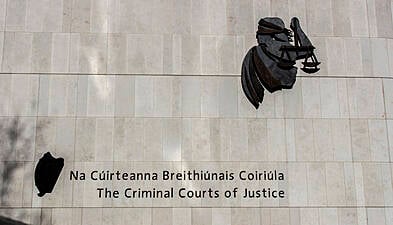Lawyers for a security professional accused of being part of a violent group which attacked security guards at a repossessed farmhouse have told a jury that the prosecution's evidence against him is too weak to safely convict him.
David Lawlor (43), of Bailis Downs, Navan, Co Meath, is one of four men on trial for their alleged roles in the early morning attack at the rural property at Falsk, just outside Strokestown, Co Roscommon.
The previous owners of the property, Anthony McGann and his siblings, had been forcibly evicted five days earlier by security men acting on behalf of the High Court and KBC bank.
The jury at Dublin Circuit Criminal Court heard evidence from four men guarding the house at around 5 am on December 16th, 2018.
They said a group of around 30 men arrived at the house and smashed their way inside, armed with weapons, including a baseball bat, a meat cleaver, a hurley, a stick with nails in it, and a chain saw and attacked the men present.
Mr Lawlor is charged with false imprisonment and assault causing harm to four security personnel, aggravated burglary, arson of four vehicles which were set alight, criminal damage to the front door of the house, violent disorder, robbery of a wristwatch from one security guard and finally, causing unnecessary suffering to an animal by causing or permitting an animal to be struck on the head.
His co-accused, Patrick J Sweeney (44), of High Cairn, Ramelton, Co Donegal, Martin O'Toole (58), of Stripe, Irishtown, Claremorris, Co Mayo, and Paul Beirne (56), of Croghan, Boyle, Co Roscommon, are charged with the same 17 counts. All four men have pleaded not guilty to the charges.
It is the State's case that one of the alleged victims, Ian Gordon, recognised Mr Lawlor's voice during the assault.
The two men had allegedly met a number of times while working as security professionals during concerts at Croke Park and Marley Park and at the Electric Picnic festival.
On day 41 of the trial, Seamus Clarke SC, defending Mr Lawlor, told the jury that by its own admission, the prosecution case against his client is based wholly on circumstantial evidence.
He said this could be broken down into the alleged evidence of Mr Lawlor's car, the evidence from his phone and, finally, the voice recognition evidence.
He said the prosecution has compared each of these pieces of evidence to strands which, when taken together, can form a rope which is strong enough to take the weight of conviction. He said the defence case is that none of the pieces of evidence meets the burden of proof and compared them to “frayed threads”.
The most important evidence is that which doesn't fit in
Citing established case law, he said the proneness of the human mind is to look for and often slightly distort the facts in order to establish a proposition of guilt. He said that the case law states a single circumstance which is inconsistent with such a proposition is of more importance than all the rest.
“In other words, the most important evidence is that which doesn't fit in,” he said. He added that where there are two alternative explanations open to the jury in relation to any piece of evidence, the jury must, by law, take the one that is favourable to a defendant.
Fleeting glance
He said the evidence Mr Gordon claimed he recognised his client's voice based on only nine words: “This is Ian Gordon, ex UDR, ex-Loyalist paramilitary.” He said this was the equivalent of a fleeting glance in visual identification evidence.
He said the prosecution claims these words matched up to words Mr Gordon had heard Mr Lawlor speak at a previous public protest against an eviction in Balbriggan were untrue and that Mr Gordon was “loose with the words he throws around”.
The purported voice recognition took place in a highly stressful situation where a witness is under attack, and there is a lot of background noise, including a chainsaw, Mr Clarke said.
He said that the trial judge, Judge Martina Baxter, would give a legal warning about the dangers of making mistakes in voice recognition evidence. He said the animosity between Mr Lawlor and Mr Gordon, whom Mr Lawlor alleged previously took part in the eviction of Mr Lawlor's home in Meath, cut both ways.
He said Mr Gordon had made a complaint to gardaí against Mr Lawlor after an alleged assault at the Balbriggan protest but this complaint was not supported by any gardaí present at that protest and there was no prosecution.
He said Mr Gordon was placing his client at Falsk, but “you don't know if it’s done maliciously or by mistake”. He said there was evidence that called Mr Gordon's credibility as a witness into question.
'Stop it, Davey'
During the assault, Mr Gordon allegedly heard somebody say, “Stop it, Davey,” before he alleges he heard Mr Lawlor speaking. He told the jurors they had to be very careful because this was all coming from Mr Gordon as there was evidence from the person who allegedly spoke those words.
He said out of 7,700 pages of detailed messages found on his client's mobile phone, Mr Lawlor is referred to as David, Dave or D, but “nowhere is he referred to as Davey”.
He said that Mr Gordon gave evidence that all the staff working for him at Falsk were licensed to work in the Republic of Ireland, but the jury later heard that his company was successfully prosecuted for operating without a licence.
He described as ridiculous Mr Gordon's claims that the men on site who did not hold a license to work as a static guard in this jurisdiction were hired as gophers or cleaners.
“He told you bare-faced lies. If he is prepared to lie on oath, how can you trust him when he purports to identify Mr Lawlor's voice,” Mr Clarke told jurors.
He said the evidence from mobile phone cell sites merely showed that Mr Lawlor may have travelled on the night from Dublin to Elfin, Co Roscommon, but it did not necessarily place him at Falsk.
He said the prosecution had relied on CCTV footage to purport to identify Mr Lawlor's car travelling in a convoy from Elfin towards Falsk but that the brake lights on the car in the CCTV were later shown to be different to the brake lights on Mr Lawlor's car.

He said it was a completely rational explanation that Mr Lawlor went to Roscommon that night but did not continue to Falsk and did not participate in the events there. He compared it to the protests at the British Embassy in Dublin after Bloody Sunday and said they had gone on for days, and some people left when they became violent.
He said the messages found on his client's mobile phone at most show his client knew an event was taking place, but there is no evidence he was involved in organising it and “no evidence any sort of mayhem planned”. He said there was no evidence of violent endings at other protests to take back houses which his client was linked to.
He told jurors that they must consider whether it is reasonably possible that the defendant did not attend at Falsk, that Mr Gordon is either mistaken or deliberately misidentifying him. He said that the prosecution had failed to prove beyond reasonable doubt that his client was at Falsk or that he was part of a joint enterprise to “cause mass mayhem”.
The trial continues.







